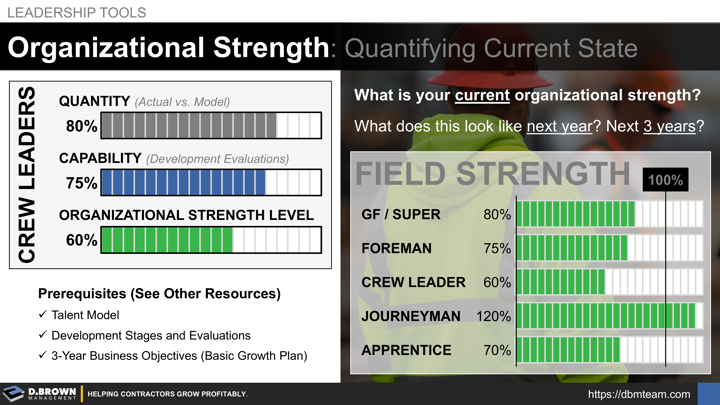This is conceptual by design — every contractor will approach it a bit differently and integrate it with their current systems. It provides basic quantification for your current-state org structure planning and evaluation. Other related tools and prerequisites include:
- Talent Model (Ratios and Metrics for High-Volume Roles)
- Development Stages and Evaluations (Fully Capable and Multipliers)
- 3-Year Business Objectives (Basic Growth Plan)
Remember that these will get progressively more complex with each stage of growth. What matters is getting started to the point of being able to improve your Talent Value Stream (TVS).
You can get to a rough version of this with a small team, a whiteboard, and a few hours. The basics are being able to evaluate the capabilities of your existing team to understand roughly what capacity they can run at. Are they running closer to 100% on average or a newer team that is running at 50%.
For example, if the target for PMs is to manage $15M in work but you have gone through a growth spurt and have a newer team, that average may be in the $10M range currently. You’re already assigning workload this way — knowing that some people can handle $18M worth of work (though it will stretch them), while for others, the safe range is $8M over the next year as they learn your systems and build capabilities.
The other dimension is just the quantities that you have in a given role as compared to your target metrics (see Talent Model). For example, if your metric for a Foreman is managing an average crew of 8 and average revenue of $2.5M per year, and your plan for the next 12 months is $50M then you need to have about 20 Foreman who can operate at full capacity. If you only have 16 available, then you are running at 80% based on quantity alone.
Remember, these are just examples — every contractor operates differently depending on their structure, scope(s) of work, industry sector(s), and geography(s). With a little analysis, you can develop your own metrics pretty easily and they will improve over time with feedback.
Organizational Strength is just a product of Quantity X Capability. In the example image above, the contractor has 80% of the Crew Leaders required (Quantity) and across that group, they are running at 75% Capability — the demonstrated ability to do the tasks required for the role. This leaves the Organizational Strength for the Crew Leader role at 60%.
This is not a judgement on any single person, just something that is important to know when planning the work.
What does this mean if you were looking at the whole field management pipeline and it looked like the diagram above?
- General Foreman / Superintendent: 80% Strength
- Foreman: 75%
- Crew Leader: 60%
- Journeyman: 120%
- Apprentice: 70%
Again, this is all conceptual in example. When applied to your specific company — including your team, business plans, contract backlog, and opportunity pipeline — this leads to more meaningful discussions. Some observations and questions might include:
- There’s a gap at the top three levels of field leadership, so each layer is likely doing one of three things:
- Dipping down to fulfill the responsibilities of those below them, while investing more time in training and letting some of their own responsibilities slide.
- Working excessive hours to compensate, which can lead to stress, safety issues, mistakes, burnout, and turnover.
- Assuming the work is simply getting done — but abdication of management responsibilities is very different from effective delegation.
- How much of the driver of the lower Organizational Strength at the Crew Leader, Foreman, and GF/Super layers are driven by Capabilities that can be improved?
- What are the specific responsibilities (tasks or decisions) that would improve outcomes the most if they can be developed?
- What are all the resources inside the company that could help train and coach?
- Are there external resources?
- Is there a way to reassign either temporarily or permanently some of those tasks to a different role?
- There don’t appear to be enough Apprentices coming in to build Journeyman capacity if growth is planned for the future.
- There is 120% strength at the Journeyman level which is great for training Apprentices, quality, and safety. What is the reason that some of those have not moved to Crew Leader roles? Is it driven by desire, aptitude, capabilities, or something else? Many mistakes are made by promoting the wrong people at the wrong times to the wrong roles. That is incredibly prevalent in the construction industry from craft to supervisor, so this is worth digging into.
On that last point, we’ve seen many situations where people with the aptitude to succeed as Crew Leaders or Foremen preferred to remain at the journeyman level — often because they see too many examples of poor performance, stress, complaints, and turnover at the field management levels. We’ve seen this flow unblocked by removing a few people who were in the wrong roles — this is “addition by subtraction.” It’s never the desired path, but it’s often the necessary one for moving forward.
Once you get your head around your current organizational strength and start making improvements, the next step is looking ahead over the next 3 years.

